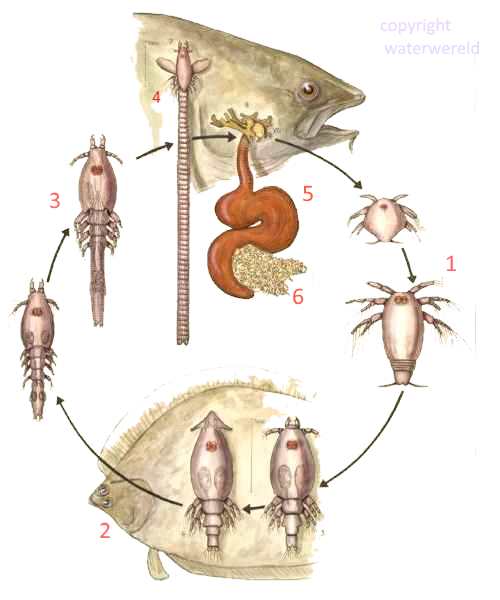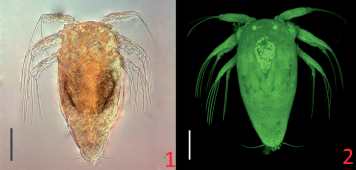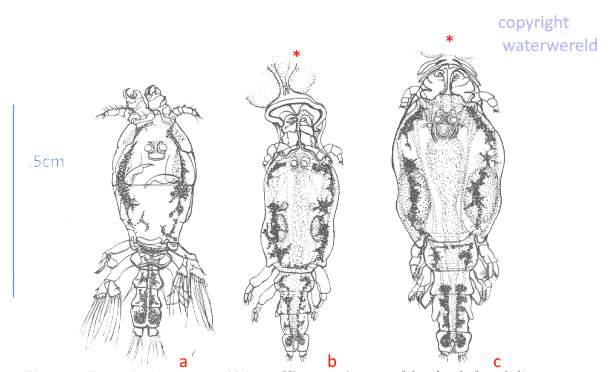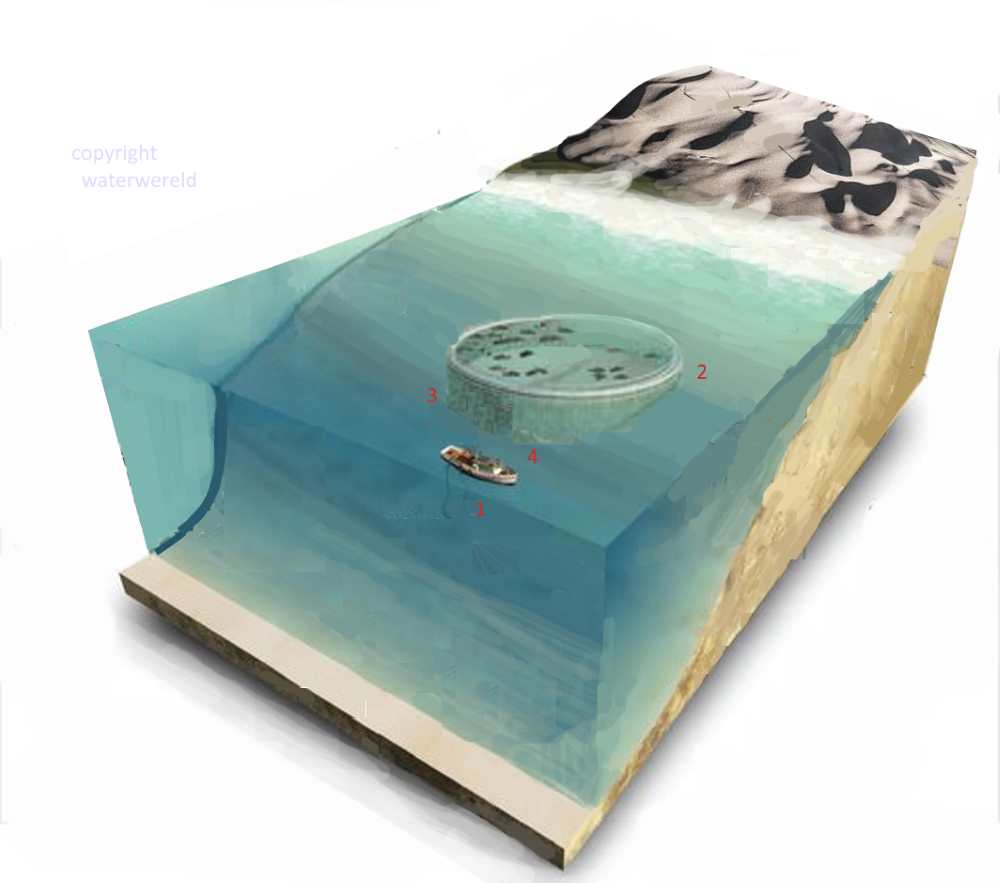cod worm
The cod worm is marine copepod. This is one of the most important parasites for cod , and other cod-like fish, like herring whiting and haddock (gadids). It has a large impact on the fishery in the Atlantic Ocean. The cod worm is a large copepod, up to 4 c-m long , and is attached to the gills of the cod. Cod, herring or haddock can be infected when young , and once infected , they will loose weight, and have dificulties in mating. Also, because of infection of the wound, they will spread bacterial infections.

cod worm live cycle
lernaeocera branchialis or cod worm is found mainly in the North Atlantic.
(1) It is starts life as a small pelagic crustacean larvae, it is called ” nauplius” . It is part of the plankton ,and lives from the yolk. It only remains only shortly in the upper levels of the sea, it will transform into a free swimming copepodid and sink to the bottom of the sea, looking for a host.
(2)The first host used by cod worm is a flatfish or lumpsucker, which they capture with grasping hooks at the front of their bodies. They penetrate the lumpsucker or flatfish with a thin filament which they use to suck its blood. The nurished cod worms then mate on the lumpsucker : the eggs are fertilized.
(3) The female worm carrying the eggs, then finds a cod-like fish.
(4) There, the worm clings to the gills while it metamorphoses into a plump, sinusoidal, wormlike body (5), with a coiled mass of egg strings at the rear(6). The front part of the worm’s body penetrates the body of the cod until it enters the rear bulb of the host’s heart. There, firmly rooted in the cod’s circulatory system, the front part of the parasite develops like the branches of a tree, reaching into the main artery. In this way, the worm extracts nutrients from the cod’s blood, remaining safely tucked beneath the cod’s gill cover until it releases a new generation of offspring into the water. (1)
Cod worm illustrations

Nauplius II or the first stage of the cod worm , seen in normale light (1) (phase contrast enhanced) and green laser light (confocal microscopy)(2). Using the laser light makes it easier to recognize details. A nauplius has only a head and a tail, nothing between it (no thorax or abdomen).

copepodid stadia, females:(a), free swimming , looking for a host, (b) attached to a flatfish : they use a thin ligament (*)to feed upon their host. (c) male , attached to a flatfish.

After infection of the gills of the cod, the female cod worms transforms grosly . It will penetrate into the aorta, and produces enormous amounts of eggs. (9)
The codworm and the cod fishery
L. branchialis has major effects on the aquaculture industry and with gadoid (especially cod) farming expanding in several North Atlantic countries, there is considerable potential for this parasite to become a serious problem for commercial mariculture.(1)
The cod worm and the wild cod
The cod worm feeds on the blood of the cod, causes a lot of symptoms like: abnormal behaviour, reduced growth, reduction in fat content and liver weight, low haemoglobin and haematocrit, emaciation, lethargy, decreased reproductive potential, and may result in death of the fish, particularly
if the infected host is young and in cases of multiple parasite infection. (4)
Also : the fish becomes unedible. The mortality rate in wild Atlantic cod is somewere between 8 and 20 percent (5)
Cod farming and the cod worm
Cod farming increase the vulnerability of these fish for infection with the cod worm: Also that already infected cod suffered higher mortality
levels when subject to stressful handling events, simultaneous
infections with other pathogens, or pollution exposure (7)

1 feeding and transportation of cod produces stress
2 other pathogens can infect pod simultaneous and the pod worm can spread easely to flatfish and so to nearby cod farms.
3 the infected cod produce a large amount of nauplius that can escape in the plankton through the net
4 pollution from the cod produces stress on the cod .
Is there a prevention possible for the cod worm infections?
-An environment with salinities below 20 gives protection against infection with L. branchialis,(6). These low salanity levels can be found near the estuaria of rivers and in the Baltic sea.
reference
1 A review of the biology of the parasitic copepod Lernaeocera branchialis (L., 1767) (Copepoda: Pennellidae). Brooker AJ1, Shinn AP,
2 WoRMS taxon details
3 The fate of Lernaeocera branchialis (L.) (Crustacea; Copepoda) in Atlantic cod, Gadus morhua L. Baily JE1, Smith JL, Wootten R, Sommerville C.
4 Description of the free-swimming juvenile stages of Lernaeocera branchialis (Pennellidae), using traditional light and confocal microscopy methods Article
5 .Khan, R. A., Lee, E. M., and Barker, D. 1990. Lernaeocera branchialis:
a potential pathogen to cod ranching. Journal of Parasitology,
76: 913e917
6 Khan, R. A., and Lee, E. M. 1989. Influence of Lernaeocera branchialis
(Crustacea: Copepoda) on growth rate of Atlantic cod,
Gadus morhua. Journal of Parasitology, 75: 449e454.
7 Lernaeocera branchialis (L., 1767) on cod in Baltic waters | SpringerLink link.springer.com/article/10.1007/BF02908707
